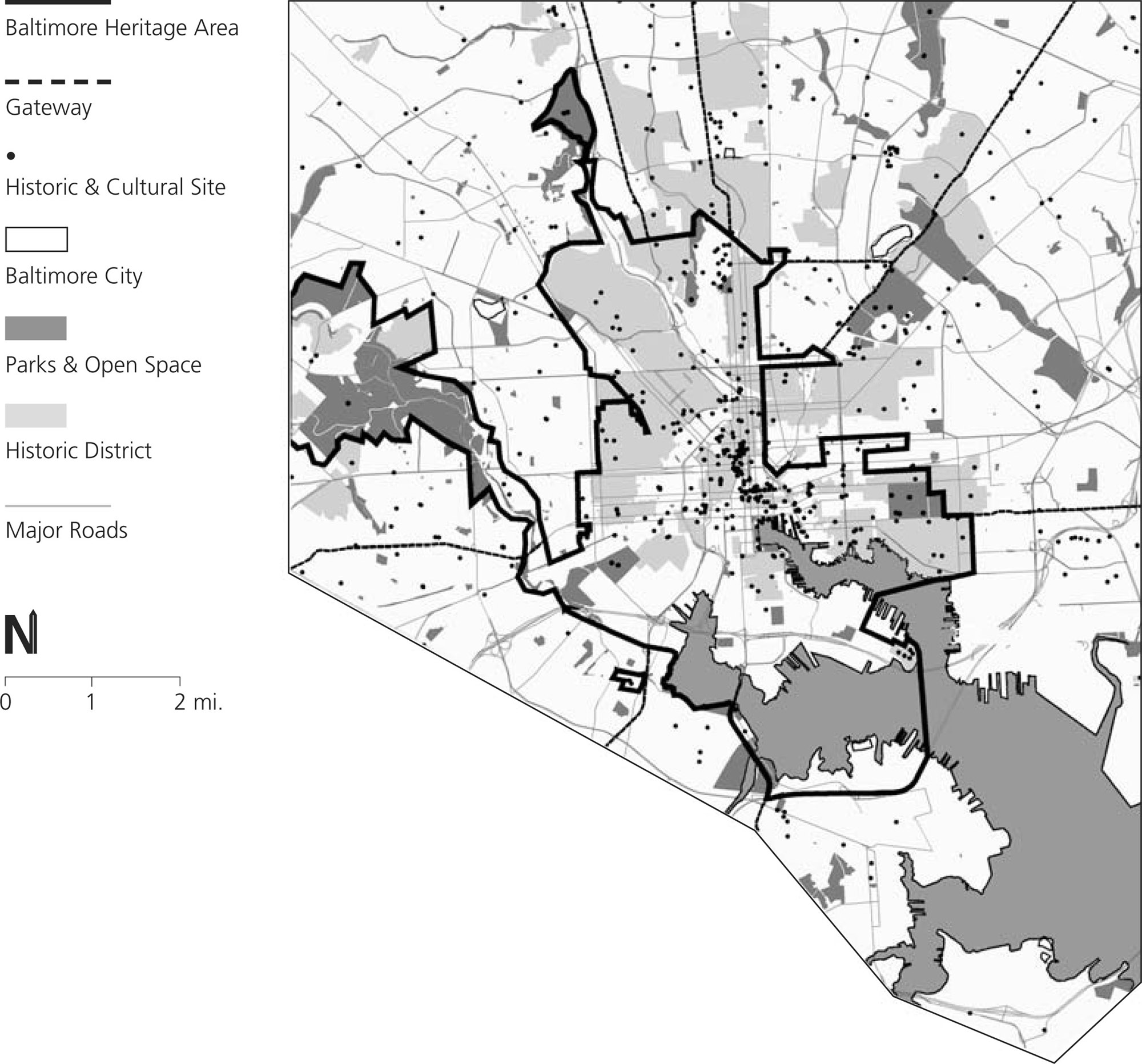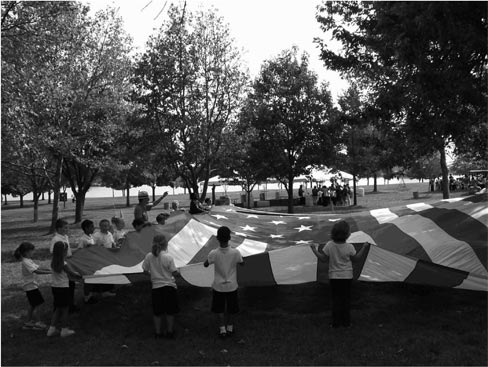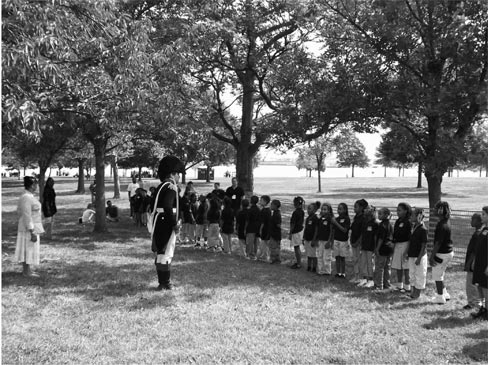Research Report
Teaching American History in Baltimore, Maryland
by Abbi Wicklein-Bayne
The Baltimore Heritage Area (BHA), which encompasses the heart of the city of Baltimore, Maryland, promotes the discovery and stewardship of the city's heritage resources, the revitalization of historic neighborhoods, and the development of business opportunities in heritage tourism.(1) It was established in 2001 by the Maryland Heritage Areas Authority in recognition of the outstanding quality of the city of Baltimore's historic, cultural, and natural resources and its potential to foster greater understanding of the seminal role Baltimore has played in the nation's history. The BHA stands out among Maryland's 11 certified state heritage areas as the state's only major urban heritage area containing a large number of contributing cultural and natural resources within a small geographic area.(2)(Figure 1)
 |
Figure 1. The Baltimore Heritage Area in the heart of Baltimore, Maryland, is the state's largest urban heritage area. (Courtesy of the Baltimore Heritage Area.) |
Soon after its establishment, the BHA began working with the Greater Baltimore History Alliance (GBHA), the city's consortium of history museums and historic sites, to identify concerns within the heritage tourism community and to determine how the BHA might help address those concerns.(3) Chief among them was the significant decline since the late 1990s in the number of students participating in field trips to museums and historic sites within the heritage area. Informal surveys revealed, moreover, that the number of students enrolled in the Baltimore City Public School System (BCPSS) who took advantage of local cultural resources lagged far behind those of neighboring jurisdictions. Some people have attributed this overall decrease in numbers to a shift in emphasis towards standardized testing and away from social studies and local and American history. In Baltimore City, budgetary constraints that precluded bus transportation to museums and historic sites and low household incomes among the student population only exacerbated the decline.(4)
In response, the BHA created a staff position to act as liaison between the GBHA and the school system. That person's primary task was to find ways to help Baltimore City public school students gain access to the city's rich cultural heritage resources.
In 2004, the BHA, working in cooperation with the BCPSS social studies curriculum supervisor, the Friends of Fort McHenry, the Maryland Historical Society, the Flag House and Star-Spangled Banner Museum, and the Maryland State Department of Education, developed a pilot program for increasing public school student attendance at Defenders Day at Fort McHenry National Monument and Historic Shrine in Baltimore.(5) In June of that year, the BHA and its partners invited 50 public school teachers from Baltimore City and surrounding Maryland counties to participate in a one-day teachers' institute at Fort McHenry.(6) Each participant received a small stipend for the day and a guarantee of bus transportation to the fort for their students during Star-Spangled Banner Weekend. On Friday, September 8, 2004, approximately 1,250 students, 800 of them from Baltimore, boarded buses to the fort for the Star-Spangled Banner Weekend's Young Defenders program.(Figures 2-3)
 |
Figure 3. Students spend time with Francis Scott Key (played by National Park Service Ranger Alan Gephardt) at the Young Defender's Program at Fort McHenry in Baltimore. (Courtesy of the author.) |
The positive feedback from the teachers encouraged BHA and its partners to think about continuing and expanding the pilot program. BCPSS, especially the social studies curriculum supervisor, viewed the pilot program as an innovative way of providing professional development for city schoolteachers. As in other urban school systems, teachers in Baltimore's public schools face considerable challenges, and cultural institutions often overlook them as potential partners. The BHA and the GBHA quickly discerned the magnitude of the demand among teachers for professional development opportunities that enable them to take advantage of resources available locally for their students.
The BCPSS social studies office worked closely with the Baltimore Heritage Area to secure financial support for an expanded program that included museum- and site-based lesson plans, on-site teachers' institutes, and field trips.(7) A second round of teachers' institutes took place at the Maryland Historical Society, the Baltimore Museum of Industry, the Baltimore and Ohio Railroad Museum, and the Jewish Museum of Maryland. Each session was limited to 20 secondary and 20 elementary school teachers and generated long waiting lists.
Prior to each institute, master teachers from the Baltimore City public schools worked with museum educators and other museum staff to create thematic lesson plans tied to school curricula using primary resources in the museum's collection. Each museum either prepared a collection of scanned images for classroom use or provided a museum membership for future visits. On the day of the institute, the teachers took a behind-the-scenes tour of the archives or collections space and had the chance to speak with museum professionals and volunteers about how their students could make use of research facilities and libraries. The BCPSS master teachers then presented their lesson plans, which can serve as a pre-visit lesson for a field trip or as a stand-alone lesson aligned with the curriculum if a field trip is not possible.
In early 2007, the BCPSS, the BHA, and the GBHA received a $75,000 National Endowment for the Humanities We the People grant for a series of six more teachers' institutes. In June 2007, the group, in partnership with the Gilder-Lehrman Institute of American History and Towson University, received $1 million from the federal Teaching American History Program for "Teaching American History in Authentic Baltimore," a three-year professional development program for BCPSS teachers.
In less than four years, the BHA had achieved the goal of creating an exciting, partnership-based professional development program for public school teachers that involved museums, historic sites, and the city public school system. However, the final piece of the puzzle had yet to fall into place. Although some of the participating teachers had found ways to organize and carry out field trips, field trip transportation costs remained beyond the financial reach of many schools within the city.
The heritage area earmarked $10,000 in its 2007 budget for a joint project with the GBHA to create a transportation fund for public school students. The GBHA, which matched the funding dollar-for-dollar, made small grants available on a competitive basis to museums for bus transportation to their sites. Museums and sites that applied in partnership with one another, provided evidence of curriculum-based programming, offered reduced entrance fees, or waived the fees altogether received priority consideration. The GBHA awarded the transportation grants in August 2007 for field trips scheduled to take place between October and June during the 2007-2008 school year.
At the end of the school year, the BHA will compare public school student attendance numbers against those from the previous year to gauge the impact of its expanded teachers' institute program. The BHA is confident that the figures will show a marked increase in the number of students who benefited from improved access to Baltimore's historic resources.
About the Author
Abbi Wicklein-Bayne served as heritage education and outreach administrator for the Baltimore Heritage Area during the "Teaching American History in Authentic Baltimore" grant period. She is currently the assistant director of the Mount Clare Museum House in Baltimore.
Notes
1. The Baltimore Heritage Area maintains a website at http://www.ci.baltimore.md.us/government/heritage/, accessed on October 30, 2007.
2. Visit http://www.marylandhistoricaltrust.net/hb-1.html (accessed on October 30, 2007) for more information on the Maryland heritage areas program.
3. The Greater Baltimore History Alliance maintains a website at http://www.baltimoremuseums.org, accessed on October 30, 2007.
4. Within the Baltimore City Public School System, for instance, approximately 75 percent of all students qualify for free or reduced meals. At some schools, the percentage is as high as 95 percent. The statewide average is 36 percent. Baltimore City Public Schools Department of Research, Evaluation, Assessment and Accountability, 2005.
5. Defenders Day and Star-Spangled Banner Weekend at Fort McHenry commemorate the September 13-14, 1814, Battle of Baltimore during the War of 1812. This battle resulted in an American victory over the British at the fort. During the battle, Francis Scott Key penned the lines to the poem, "The Defense of Fort McHenry," which is better known as the "Star-Spangled Banner," the national anthem of the United States. The BHA developed the pilot project to meet former Baltimore City Mayor Martin O'Malley's objective to increase public school student attendance at the event. For more information on the Star-Spangled Banner Weekend, see "Fort McHenry National Monument and Historic Shrine," http://www.nps.gov/fomc/, accessed on October 31, 2007.
6. The BHA reserved 25 of the 50 seats for Baltimore City public school teachers.
7. The BCPSS dedicated funds from a U.S. Department of Education Teaching American History grant to expand the pilot program.

